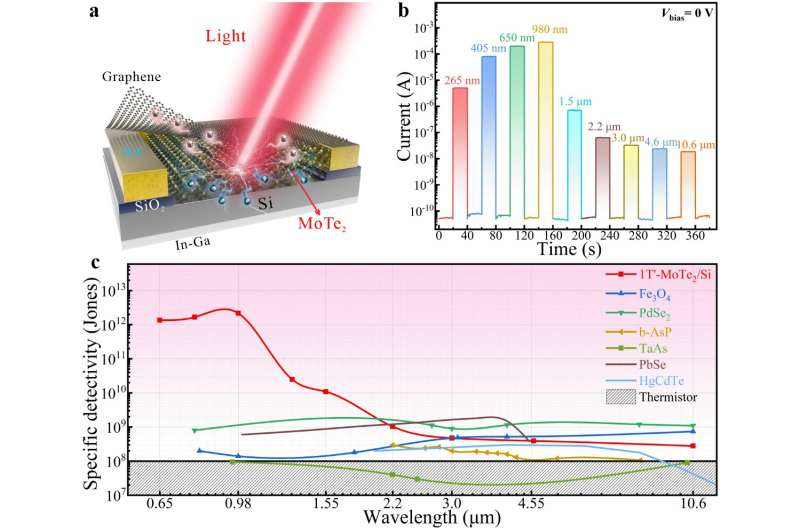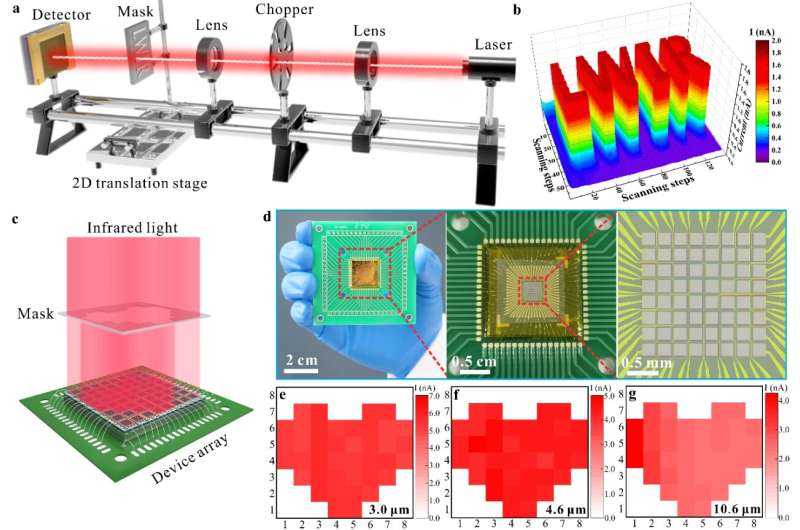This article has been reviewed according to Science X's editorial process and policies. Editors have highlighted the following attributes while ensuring the content's credibility:
fact-checked
peer-reviewed publication
trusted source
proofread
Wafer-scale 2D MoTe₂ layers enable highly-sensitive broadband integrated infrared detectors

Detection in multiple infrared (IR) regions spanning from short- and mid- to long-wave IR plays an important role in diverse fields from scientific research to wide-ranging technological applications, including target identification, imaging, remote monitoring, and gas sensing. Currently, state-of-the-art IR photodetectors are mainly dominated by conventional narrow bandgap semiconductors including In1-xGaxAs, InSb, and Hg1-xCdxTe, operating in short-wave IR (SWIR, 1-3 µm), mid-wave IR (MWIR, 3-6 µm), and long-wave IR (LWIR, 6-15 µm) spectral bands, respectively.
Notably, these photodetectors not only rely on high-temperature growth process of raw materials and complex processing technique, but also suffer from the cryogenic cooling conditions with time-consuming and high power consumption. Moreover, there are several remaining technological challenges, such as poor complementary metal-oxide-semiconductor (CMOS) compatibility, bulky module size and low efficiency, which severely restrict the wider application of these detectors.
In a new paper published in Light Science & Application, Professors Di Wu and Xinjian Li from Zhengzhou University, Dr. Longhui Zeng from the University of California-San Diego, and Prof. Jiansheng Jie from Soochow University have demonstrated a facile thermal-assisted tellurization route for the van der Waals (vdW) growth of wafer-scale phase-controlled 2D MoTe2 layers. The type-II Weyl semimetal 1T′-MoTe2 layers were directly deposited on prepatterned Si substrate to fabricate in-situ a 1T'-MoTe2/Si vertical Schottky junction. The high-quality Schottky junction interface and vertical device structure with graphene electrodes ensure efficient carrier transport and reduce carrier recombination, enabling the detector to achieve an ultrabroadband detection range of up to 10.6 μm and a room-temperature specific detectivity of over 108 Jones in the mid-infrared region. The wafer-scale 2D MoTe2 layers also enable the integrated device array to be successfully implemented for high-resolution, uncooled, mid-infrared imaging.
In this study, a pre-deposited Mo film as a precursor was transformed to 2D MoTe2 layer via vdW growth mechanism through a direct thermal-assisted tellurization process. As a matter of fact, the phase transition of MoTe2 is highly dependent on the growth time. By controlling the growth time, 2-inch 2H and 1Tʹ- MoTe2 layers with good uniformity were obtained, respectively. By virtue of the facile and scalable thermal-assisted tellurization strategy, the thickness of the 2D MoTe2 layers could be precisely tailored by tuning the initial Mo film thickness.

The vdW growth of the large-area 2D MoTe2 layers offers more flexibility for the development of high-sensitivity optoelectrical devices. In light of this, a 1Tʹ-MoTe2/Si vertical Schottky junction device was developed by the in-situ vdW growth of 1Tʹ-MoTe2 layers on a pre-patterned Si substrate. To ensure the efficient carrier collection, monolayer graphene was selected as a top transparent contact with a 1Tʹ-MoTe2 layer. The photodetector demonstrates high-sensitive self-powered ultrabroadband detection performance with a detection range of up to 10.6 µm and a large room-temperature specific detectivity of over 108 Jones in the mid-infrared (MIR) range. The obtained room-temperature specific detectivity is superior to the most 2D material-based IR detectors and some commercial detectors.
Given the superior IR detection capability of the photodetector, the room-temperature IR imaging was further explored with the Gr/1Tʹ-MoTe2/Si Schottky junction device. The photocurrent mapping image of "LWIR" pattern with a large current contrast ratio over 10 and sharp edges was obtained from an individual detector under the IR illumination of 10.6 μm at room temperature. Furthermore, the large-scale uniform 2D MoTe2 layer enables the fabrication of an 8 × 8 1Tʹ-MoTe2/Si Schottky junction device array for IR imaging application.
Upon MIR laser illumination, the large difference between the currents of the exposed and unexposed pixels results in a high-resolution heart-shaped image with large current ratios of 100, 68, and 51 for 3.0, 4.6, and 10.6 μm laser illumination at room-temperature, respectively. Such excellent room-temperature imaging capability with good homogeneity of the device array gives this finding great promise for MIR imaging applications. The wafer-scale growth of 2D MoTe2 layers compatible with Si technology shows great potential for next-generation on-chip Si CMOS systems with low-power consumption and low-cost production.
More information: Di Wu et al, Phase-controlled van der Waals growth of wafer-scale 2D MoTe2 layers for integrated high-sensitivity broadband infrared photodetection, Light: Science & Applications (2023). DOI: 10.1038/s41377-022-01047-5
Journal information: Light: Science & Applications
Provided by Chinese Academy of Sciences





















